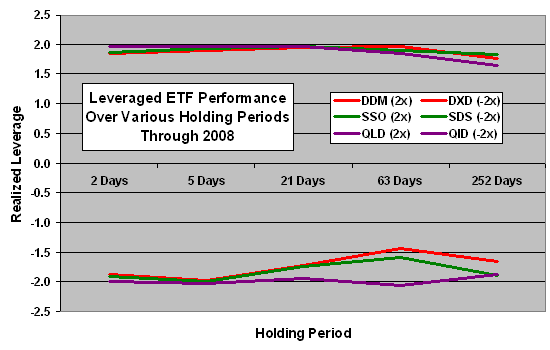How closely do leveraged exchange-traded funds (ETF) track their nominal, short-term design leverages over extended holding periods? In their February 2009 paper entitled “Long Term Performance of Leveraged ETFs”, Lei Lu, Jun Wang and Ge Zhang measure the realized leverages for several Ultra (2x) and UltraShort (-2x) ETFs from the ProShares family. Using daily returns for Diamond Trust Series 1 (DIA), S&P Depository Receipts (SPY), PowerShares QQQ (QQQQ) and iShares Russell 2000 Index (IWM), and for their corresponding 2x and -2x ProShares leveraged ETF pairs, from inception of the leveraged funds through December 15, 2008, they conclude that:
- For very short holding periods, investor can safely assume that Ultra (UltraShort) ETFs provide close to twice the return (twice the negative return) of the underlying benchmark.
- For extended holding periods, cumulative returns of leveraged ETFs, especially the UltraShort ETFs, can deviate considerably from their short-term leverage targets.
- Leveraged ETFs are not precise long-term substitutes for long or short positions.
The following chart, constructed from data in the paper, shows the actual leverage achieved by three sets of leveraged ETFs from inception through 2008 for (overlapping) holding periods of 2, 5, 21, 63 and 252 trading days, as follows:
- DDM and DXD as the Ultra and UltraShort for DIA
- SSO and SDS as the Ultra and UltraShort for SPY
- QLD and QID as the Ultra and UltraShort for QQQQ
The chart shows that realized leverage over extended holding periods can vary considerably from the nominal, short-term design leverage, especially for ultrashort ETFs.

The paper does not explore how specific market conditions may relate to deviations from the short-term design leverage. The direction and magnitude of deviation may relate to the trends and volatilities of the returns for the underlying benchmarks. The sample periods in this study are too short for confident generalizations about the direction and magnitude of deviations.
In summary, very limited evidence shows that the actual leverages of leveraged ETFs vary considerably from their short-term design values over extended holding periods.